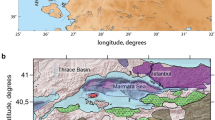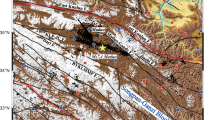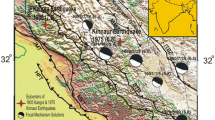Abstract
Tehran region is located at the southern foothills of central Alborz Mountains which is one of the most seismically active regions due to the convergence between the Arabian and the Eurasian plates. In this study, 3-D crustal velocity structure of Tehran region was investigated using first P-wave arrival times of events with magnitudes less than 4. Data used was recorded by the stations from Tehran Disaster Management and Mitigation Organization, Iranian Seismological Center and International Institute of Earthquake Engineering and Seismology from 2004 to 2018. In order to obtain the crustal velocity structure of Tehran, iterative, damped least-squares method was used to solve/obtain earthquake parameters and velocity structures, simultaneously. Final results show three tectonic characteristics in the study area including high velocity anomalies in northern and eastern Tehran Mountains, and low velocity anomaly in triangular Tehran basin, so that the separation of the eastern Tehran Mountains and Tehran basin is especially sharp in cross-section profiles. Moreover, some low velocity anomalies are appeared around major faults in the study area (e.g. North Tehran Fault). The tomographic maps also show that the Tehran region contains of an upper crust layer with the thickness of 6 km which is located over middle crust layer bedrock with constant velocity up to 15 km. This upper crust layer consists of a sedimentary layer (~ 3 km thickness) overlaid a basement layer. Moreover, the thick and thin upper crust layers are separated by North Tehran and Kosar/Ghasr-Firooz faultsystems from the Tehran basin, respectively.









Similar content being viewed by others
References
Abbasi, M. R., & Shabanian, E. (1999). Fault map of north Tehran. Tehran: International Institute of Earthquake Engineering and Seismology.
Abbassi, A., Nasrabadi, A., Tatar, M., Yaminifard, F., Abbassi, M. R., Hatzfeld, D., et al. (2010). Crustal velocity structure in the southern edge of the central Alborz (Iran). Journal of Geodynamics,49, 68–78.
Ambraseys, N., & Melville, C. (1982). A history of Persian earthquakes. Cambridge: Cambridge University Press.
Ansari, S., YaminiFard, F., & Tatar, M. (2015). Moment tensor solution of the Central-Western Alborz (Iran)earthquakes based on regional data. Scientific Quarterly Journal, Geoscience,24(95), 359–369.
Ashtari, M., Hatzfeld, D., & Kamalian, N. (2005). Microseismicity in the region of Tehran. Tectonophysics,395, 193–208.
Berberian, M. (1976). Contribution to the seismotectonic of Iran, part II. Geological Survey of Iran,39, 518.
Berberian, M. (1994). Natural hazards and the first earthquake catalog of Iran, Vol. 1. Historical hazards in Iran prior 1900, IIEES, Report.
Berberian, M., & Yeats, R. S. (1999). Pattern of historical earthquake rupture in the Iranian plateau. Bulletin of the Seismological Society of America,89(1), 120–139.
Berberian, M., & Yeats, R. S. (2001). Contribution of archaeological data to studies of earthquake history in the Iranian plateau. Journal of Structural Geology,23, 563–584.
Dehghani, G. A., & Makris, J. (1984). The gravity field and crustal structure of Iran. NeuesJahrb, Geological Paleontology,168, 215–229.
Eberhart-Phillips, D. (1990). Three-dimensional P and S velocity structure in the Coalinga region, California. Journal of Geophysical Research,95, 15343–15363.
Evans, J., Eberhart-Phillips, D., Thurber, C. H. (1994). User’s manual for SIMULPS 12 for imaging Vp and Vp/Vs: a derivative of the “Thurber” tomographic inversion SIMUL3 for local earthquakes and explosions, United States Geological Survey Open File Report 94–431.
Guest, B., Stockli, D. F., Grove, M., Axen, G. J., Lam, P. S., & Hassanzadeh, J. (2006). Thermal histories from the central Alborz mountains, northern Iran: Implications for the spatial and temporal distribution of deformation in northern Iran. Geological Society of America Bulletin,118(11/12), 1507–1521.
Haslinger, F., & Kissling, E. (2001). Investigation effects of 3-D ray tracing methods in local earthquake tomography. Physics of the Earth and Planetary Interiors,123, 103–114.
Humphreys, E., & Clayton, R. W. (1988). Adaptation of back projection tomography to seismic travel time problems. Journal of Geophysical Research,93, 1073–1085.
Jackson, J. A., & McKenzie, D. P. (1984). Active tectonics of the Alpine–Himalayan belt between western Turkey and Pakistan. Geophysical Journal of the Royal Astronomical,77, 185–246.
Jackson, J., Priestley, K., & Berberian, M. (2002). Active tectonics of the South Caspian Basin. Geophysical Journal International,148, 214–245.
Kissling, E. (1988). Geotomography with local earthquake data. Review of Geophysics,26, 659–698.
Kissling, E., Elleworth, W. L., Eberhart-Phillips, D., & Kradolfer, U. (1994). Initial reference models in local earthquake tomography. Journal of Geophysical Research,99, 19635–19646.
Kissling, E., Husen, S., & Haslinger, F. (2001). Model parameterization in seismic tomography: a choice of consequence for the solution quality. Physics of the Earth and Planetary Interiors,123, 89–101.
Lee, W. H. K., & Lahr, J. C. (1972). HYPO71 (Revised): a computer program for determining hypocenter, magnitude, and first motion pattern of local earthquakes. United States Geological Survey Open File Report,75–311, 113.
Lienert, B. R. (1994). HYPOCENTER 3.2: A computer program for locating earthquakes, locally, regionally and globally (p. 74). Honolulu: Hawaii Institute of Geophysics & Planetology.
Lomax, A., Virieux, J., Volant, P., & Berge, C. (2000). Probabilistic earthquake location in 3D and layered models: Introduction of a Metropolis-Gibbs method and comparison with linear locations. In C. H. Thurber & N. Rabinowitz (Eds.), Advances in Seismic Event Location (pp. 101–134). Amsterdam: Kluwer.
Menke, W. (1989). Geophysical data analysis: Discrete inverse theory. New York: Academic Press.
Moinfar, A., Mahdavian, A., & Maleki, E. (1994). Historical and instrumental earthquake data collection of Iran, Publication Iranian Culture. Iran: Affairs Institute.
Naghavi, M., Hatami, M. R., Shirzad, T., & Rahimi, H. (2018). Radial anisotropy in the Upper Crust beneath the Tehran Basin and surrounding regions. Pure and Applied Geophysics. https://doi.org/10.1007/s00024-018-1986-7.
Rajaee, A.H. (2007). The crustal structure in the central Alborz from receiver functions analysis, Ph.D. Thesis, International Institute of Earthquake Engineering and Seismology.
Rieben, E. H. (1955). The geology of Tehran plain. American Journal of Science,253, 617–639.
Rieben, W. H. (1966). Geological observation on alluvial deposits in northern Iran. Geological Survey of Iran,9, 39.
Ritz, J. F., Nazari, H., Salamati, R., Shafeii, A., Sokaymani, S., & Vernant, P. (2006). Active trans-tension inside central Alborz: A new insight into the Northern Iran-Southern Caspian geodynamics. Geology,34, 477–480. https://doi.org/10.1130/G22319.1.
Shirzad, T. (2019). Study of fault plane using the interferometry of aftershocks: case study in the Rigan area of SE Iran. Geophysical Journal International,217, 190–205. https://doi.org/10.1093/gji/ggz015.
Shirzad, T., Naghavi, M., & YaminiFard, F. (2018). Shallow/upper crustal shear wave structure of the Tehran region (Central Alborz, Iran) from the inversion of Rayleigh wave dispersion measurements. Journal of Seismology. https://doi.org/10.1007/s10950-018-9774-5.
Shirzad, T., & Shomali, Z. H. (2013). Shallow crustal structures of the Tehran basin in Iran resolved by ambient noise tomography. Geophysical Journal International,196, 1162–1176. https://doi.org/10.1093/gji/ggt449.
Shirzad, T., & Shomali, Z. H. (2014). Shallow crustal radial anisotropy beneath the Tehran of Iran from seismic ambient noise tomography. Physics of the Earth and Planetary Interiors,231, 16–29. https://doi.org/10.1016/j.pepi.2014.04.001.
Shomali, Z. H., & Shirzad, T. (2015). Crustal structure of Damavand volcano, Iran, from ambient noise and earthquake tomography. Journal of Seismology,19, 191–200. https://doi.org/10.1007/s10950-014-9458-8.
Sodoudi, F., Yuan, X., Kind, R., Heit, B., & Sadidkhouy, A. (2009). Evidence for a missing crustal root and a thin lithosphere beneath the central Alborz by receiver functions studies. Geophysical Journal International,177, 733–742.
Tatar, M., Hatzfeld, D., Abbassi, A., & YaminiFard, F. (2012). Microseismicity and seismotectonics around the Mosha fault (Central Alborz, Iran). Tectonophysics,544–545, 50–59.
Tatar, M., Jackson, J., Hatzfeld, D., & Bergman, E. (2007). The 2004 May Baladeh earthquake (Mw 6.2) in the Alborz Iran: Overthrusting the south Caspian Basin margin, partitioning of oblique convergence and the seismic hazard of Tehran. Geophysical Journal International,170, 249–261.
Thurber, C. H. (1983). Earthquake locations and three-dimensional crustal structure in the Coyote Lake Area. Central California. Journal of Geophysical Research,88, 8226–8236.
Thurber, C. H. (1993). Local earthquake tomography: Velocities and VP = VS-theory. In H. M. Iyer & K. Hirahara (Eds.), Seismic tomography: theory and practice (pp. 563–583). London: Chapman and Hall.
Toomey, D. R., & Foulger, G. R. (1989). Tomographic inversion of local earthquake data from the Hengill–Grensdalur central volcano complex, Iceland. Journal of Geophysical Research,94(B12), 17497–17510.
Vernant, P., Nilforouhan, F., Chery, J., Bayer, R., Djamour, Y., Masson, F., et al. (2004). Deciphering oblique shortening of central Alborzin Iran using geodetic data. Earth and Planetary Science Letters,223, 177–185. https://doi.org/10.1016/j.epsl.2004.04.017.
Wessel, P., & Smith, W. H. F. (1998). New improved version of generic mapping tools released. EOS Transactions American Geophysical Union,79, 579.
Yaminifard, F., & Moradi, A. (2011). Crustal velocity structure beneath Tehran based on teleseismic and mining explosion data recorded by Tehran City Seismic Network (TCSN). Journal of Earth and Space Physics,37(3), 59–69.
Acknowledgements
This study was supported by the Fundação de Amparo à Pesquisa do Estado de São Paulo (FAPESP), Sao Paulo, Brazil [grant number 2016/20952-4]. This study would not have been possible without the digital data sets provided by the Tehran Disaster Management and Mitigation Organization (TDMMO; http://tdmmo.tehran.ir; not openly available to the public, last accessed April 2019), Iranian Seismological Center (IrSC) at the University of Tehran/Iran (http://irsc.ut.ac.ir; openly available to the public, last accessed April 2019) and International Institute of Earthquake Engineering and Seismology (IIEES, last accessed April 2019). All plots were made using Generic Mapping Tools (GMT), version 4.2.1 (Wessel and Smith, 1998; http://www.soest.hawaii.edu/gmt, last accessed April 2019). All processing and simulations presented in this paper were performed using a Cluster system on the Institute of Astronomy, Geophysics and Atmospheric Sciences (IAG, http://www.iag.usp.br/), at University of Sao Paulo (USP). We would also like to thank the Editor and two anonymous reviewers for their constructive comments and useful suggestions.
Author information
Authors and Affiliations
Corresponding author
Additional information
Publisher's Note
Springer Nature remains neutral with regard to jurisdictional claims in published maps and institutional affiliations.
Rights and permissions
About this article
Cite this article
Shirzad, T., Naghavi, M., Afra, M. et al. Three-Dimensional P-Wave Velocity Structure of Tehran from Local Micro-Earthquake Tomography. Pure Appl. Geophys. 176, 4783–4796 (2019). https://doi.org/10.1007/s00024-019-02269-2
Received:
Revised:
Accepted:
Published:
Issue Date:
DOI: https://doi.org/10.1007/s00024-019-02269-2





